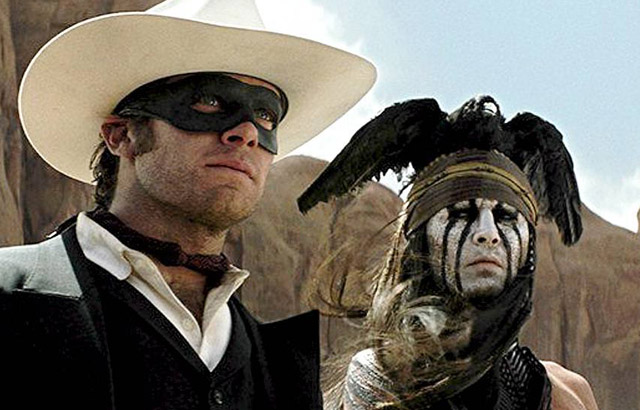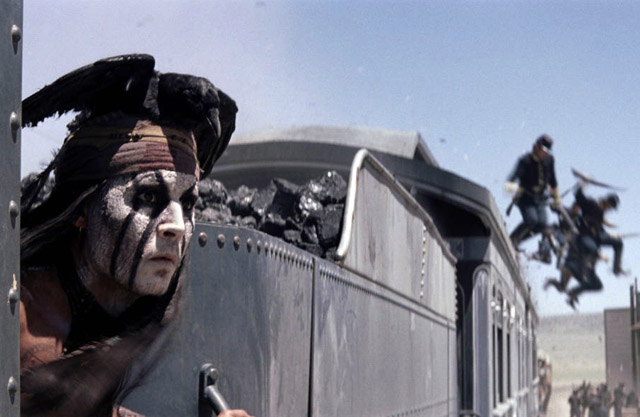CHICAGO – In anticipation of the scariest week of the year, HollywoodChicago.com launches its 2024 Movie Gifts series, which will suggest DVDs and collections for holiday giving.
‘The Lone Ranger’ Rides Again in Classic Western Style
 Rating: 3.5/5.0 |
CHICAGO – In trying to revive the Western film genre, Walt Disney Pictures is also reviving the “Pirates of the Caribbean” formula – extreme action, intrigue, flamboyant characters and Johnny Depp. Add a dash of a familiar American legend – “The Lone Ranger” – and it’s summer movie time.
“The Lone Ranger” succeeds because it also sticks to what makes a classic western fun. There are bad guys, shoot-outs, taverns of ill repute, heroes that save the day and miles of train tracks to play with in the movie, and a Native American named Tonto to add the comic relief. Thematically, the film touches upon the injustices done to the Native Americans of the old West, and makes the industrial progress of Manifest Destiny as much an enemy as Butch Cavendish. Director Gore Verbinski, the architect of the Pirates series, performs the same ritual upon “The Lone Ranger,” with the only problem being the length – TLR clocks in at over two hours, and pads that time with unnecessary exposition.
The film begins in 1930s San Francisco, at a carnival with a Wild West show. A young boy (Mason Cook) is surprised to discover that the Native American display contains a live Comanche named Tonto (Johnny Depp). The very old veteran of the 1869 Western territories starts to recount his story, the legend of John Reid (Armie Hammer), also known as The Lone Ranger.
 Photo credit: Walt Disney Pictures |
This is the origin of the character, the only Texas Ranger to survive a shoot-out ambush, which has killed John’s brother Dan (James Badge Dale). It is the notorious Butch Cavendish (William Fichtner) that has led this ambush, and the newly minted Lone Ranger dons a mask, and takes on Tonto as his partner in justice. Together, they will seek the revenge for the murders and find out who is really behind them, returning to those thrilling days of yesteryear.
Director Verbinski uses a style that combines the western film sensibility of John Ford – expansive vistas, good vs. evil morality and how history changed the West – with a kind of action gadgetry seen in the “Wild Wild West” TV show and movie. It does have comedy like his Pirates films, but it’s based more in character reactions from Tonto than the utter craziness of Depp’s Jack Sparrow character. Tonto, for all intents and purposes, is a serious character, who happens to sardonically comment on his Lone Ranger partnership and the folly of the white man’s push into his homeland.
Armie Hammer does a good job with the John Reid/Lone Ranger character, although the screenplay – by Justin Haythe, Ted Elliott and Terry Rosario –chooses to treat the legend as more farcical than serious, There are comic bits regarding the mask, the horse and the gee-whiz heroism of the persona, which was odd. The revenge factor becomes lost in carnival-like action sequences, and it becomes a bit muddled as to who or what the Lone Ranger is fighting against, but Hammer is up for the task of both hero and clown.
Also notable in this version is the mix of history and social culture. The U.S. western territories are fighting against the infiltration of the railroads, leading to the rail connection between the East and West Coast at the Promontory Summit. The “West” is up against modernity, and that includes the treatment of the Native American peoples. Tonto is a rather hangdog representative of this treatment, and the roots of his insane reaction against it is a major plot point.
 Photo credit: Walt Disney Pictures |
Where the film is a letdown is the length. It seems like every major character gets backstory exposition, and in the midst of this commentary, the film does get bogged down. But the last action scene is fairly sensational, musically scored with neck-hair-raising “William Tell Overture.” This brings us right back to the heroic source, and softens the length of the story somewhat.
It’s questionable whether modern audiences will connect to this rather old fashion Western – aside from its post historical irony – it seems we need more than a masked hero on a white horse and his faithful Indian companion. Not sure what that says about us or the Legend of the Lone Ranger. Hyyy-ooh, Silver?
 | By PATRICK McDONALD |


